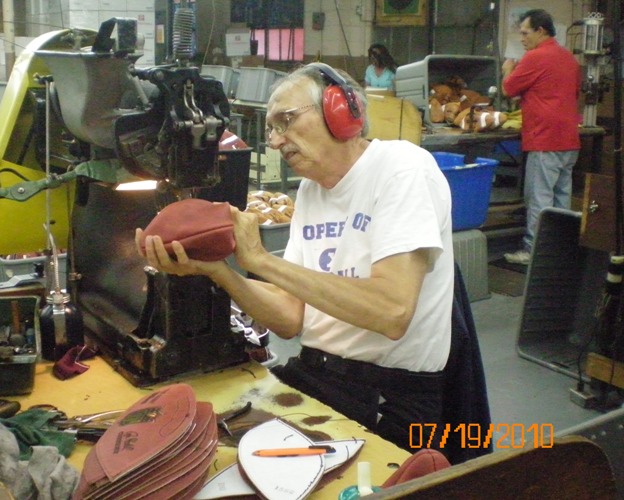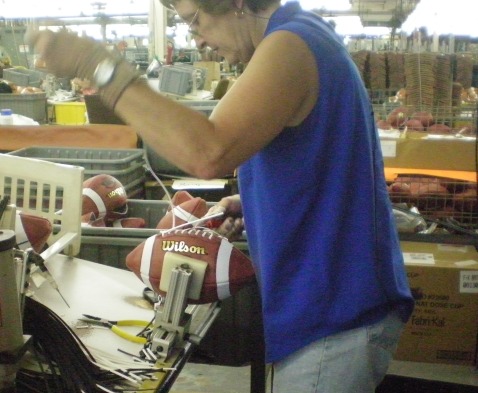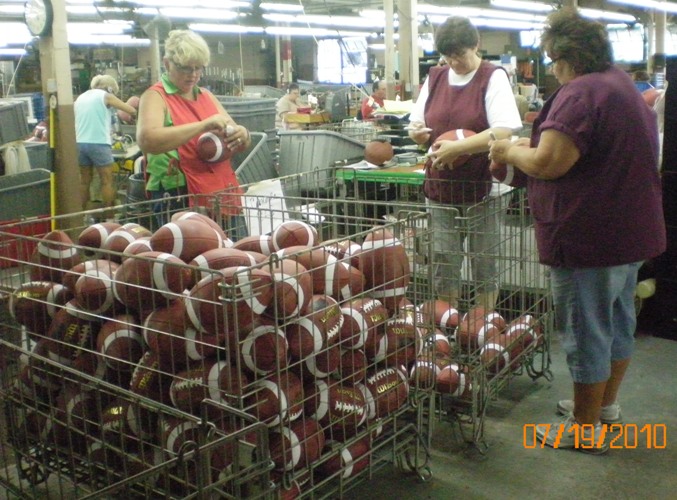|
| |
Back
to Articles Menu
Where Footballs Are Born
by
Randy Snow
Originally
posted on AmericanChronicle.com, Saturday, July 24, 2010
When
you think of great NFL cities you might think of Green Bay, Chicago, Dallas or
Pittsburgh. When you think of great NFL cities in the state of Ohio, you would
have to say Cleveland, Cincinnati and, of course, Canton, where the Pro Football
Hall of Fame is located.
But there is another city in Ohio that is just as much a part of the NFL as any
of those already mentioned. It is the booming metropolis of Ada, population
5,800! Ada has never had an NFL team, but the town produces something that is
very important to the league. It is the home of the only manufacturing facility
in the United States that makes the official Wilson footballs used by the NFL.
I knew
that the Wilson plant in Ada was unique and I wanted to see it for myself, so I
arranged for a visit and, along with my two youngest sons, recently made a trip
to the factory. It was only a three hour drive from our home in Kalamazoo, MI.
Ada is located in northwest Ohio, just east of Lima. It is also home to Ohio
Northern University, a Division III school whose team mascot is the Polar Bear.
How did this little town gain the distinction as the one and only place in the
country that makes footballs for the NFL?
 In the
1940īs, the plant was owned and operated by the Ohio-Kentucky Manufacturing
Company which made a variety of sports items such as baseball gloves and boxing
equipments. The Wilson Sporting Goods Company purchased the property in 1955 and
turned it into a plant set up exclusively to make footballs. Over the years,
other football manufacturers have sent their production operations overseas
because of the cheap labor costs, but the plant in Ada has managed to stay
competitive in the marketplace. That's how they have been able to stay in
business after all these years. In the
1940īs, the plant was owned and operated by the Ohio-Kentucky Manufacturing
Company which made a variety of sports items such as baseball gloves and boxing
equipments. The Wilson Sporting Goods Company purchased the property in 1955 and
turned it into a plant set up exclusively to make footballs. Over the years,
other football manufacturers have sent their production operations overseas
because of the cheap labor costs, but the plant in Ada has managed to stay
competitive in the marketplace. That's how they have been able to stay in
business after all these years.
There is one other factor, however, that has helped to keep the plant going.
"The National Football League is an American sport. We want the ball made in the
United States," said Dan Riegle, who has been the plant manager at the Ada
Wilson factory for the past 15 years.
As my
sons and I toured the plant, I noticed that there were very few young people
working there. "Our average plant seniority is 20 years," Riegle said. "We have
a lot of people who have been working here for 35-45 years." Riegle himself has
worked at the plant a total of 29 years.
With the exception of the office staff, the workday for the 130 employees at the
Wilson factory begins at 5:00 AM and ends at 3:30 in the afternoon. They work
four, 10-hour days, Monday through Thursday. Everyday, between 3,000 and 4,000
footballs are made by hand. The workers are paid by the piece, so exactly how
much they produce is up to them. The work is very repetitive, physical and labor
intensive. They get a 15-minute break every two hours. Having three days off
each week helps them recover from the physical work.
The
leather for the footballs comes to the factory from Chicago already dyed in one
of two different colors; the familiar brown color and a lighter tan color. The
cows all come from the Iowa, Nebraska and Kansas region of the country. No cows
are killed purely to make footballs. The cowhides are a byproduct of beef cattle
sent to market. Approximately 20 footballs can be made from a single cow. One
thing I learned on the tour was that, if you look very closely, every Wilson
football has a number of tiny "W"s stamped into the pattern of the grains.
That's how you know you have an authentic Wilson "Made in the USA" leather football.
 Football shaped pieces are cut from the leather and stacked in sets of four. The
sections are then sewn together using sewing machines that look like they should
be in a sewing machine museum. We did see one "new" sewing machine on the tour,
but it was currently out of commission. Even though our tour guide called it a
"new" machine, it still looked to me like it was made in the 1970īs! Football shaped pieces are cut from the leather and stacked in sets of four. The
sections are then sewn together using sewing machines that look like they should
be in a sewing machine museum. We did see one "new" sewing machine on the tour,
but it was currently out of commission. Even though our tour guide called it a
"new" machine, it still looked to me like it was made in the 1970īs!
Once all four pieces have been sewn together, the
footballs are turned right side out by hand and an inflatable rubber bladder is
inserted. The laces are then stitched on, again by hand. Then the footballs are
inflated to the proper pressure. The entire process takes about a week to
complete from start to finish.
Once the footballs have been inspected and
boxed up, they are shipped to Nashville, Tennessee to a distribution center.
From there they are sent out to their final destinations.
"Since 1941, every point scored in the NFL has been with a Wilson football,"
Riegle said. "Our Wilson GST football, which we introduced approximately 5 or 6
years ago, is the number one selling football in the world. It's much easier for
the high school and collegiate kids to handle because their hands are not as big
as some of the pros. It's a better grip for them. We are always trying to
innovate and come up with technological improvements that help the players play
the game better."
At every NFL game there are about 60 Wilson footballs on hand and 8 - 12 of
those are designated specifically for the kickers.
Not only is the plant in Ada the exclusive producer of footballs for the NFL,
but for about the past 10 years, they have also been the exclusive football
supplier of the Canadian Football League as well. "We're very happy to be making
their football as well," Riegle said. The plant also produces
official footballs for the NCAA and the new United Football League.
During the week leading up to the Super Bowl, the factory takes some of their
equipment to the site of the Super Bowl and sets up a working display at the NFL
Experience so fans can see exactly how the footballs are made. Usually, the
Super Bowl is held in a warm weather location far from Ohio. But in 2006, when
Super Bowl XL was played in nearby Detroit, the factory bussed many of its
employees to see the NFL Experience, and their working display, firsthand.
 January through the start of football season in the fall is their busiest time
of the year. Things actually slow down at the plant once football season kicks
off. The only time the plant is ever closed is the week between Christmas and
New Years. January through the start of football season in the fall is their busiest time
of the year. Things actually slow down at the plant once football season kicks
off. The only time the plant is ever closed is the week between Christmas and
New Years.
The plant conducts an average of one tour per week, mostly for schools kids
within a 50 mile radius of Ada. It is also the second largest employer in town,
after Ohio Northern University.
The factory has been featured on TV shows like "How it's Made" on the Discovery
Channel and John Ratzenberger's "Made in America" on the Travel Channel as well
as many local and national news shows.
"It's a unique thing that we do here," Riegle said. "There is a lot of hand
labor. That's what makes our quality so good."
The workers at the plant take a lot of pride in what they do, and each fall, the
pride of Ada is on display throughout the USA and Canada every time that a
Wilson football is ready for kickoff.
I would like to thank Dan Riegle, the plant manager at the Wilson factory for
allowing me and my two sons to visit the plant and to see the footballs being
made firsthand. I would also like to thank Barb Ulrey, one of the final
inspectors at the plant, who graciously conducted our tour.
LINKS
www.Wilson.com
Associated Press Video Essay
CBS News Video
Wilson Promotional Video 1
Wilson Promotional Video 2
Ohio Northern University
Back
to Articles Menu
|
